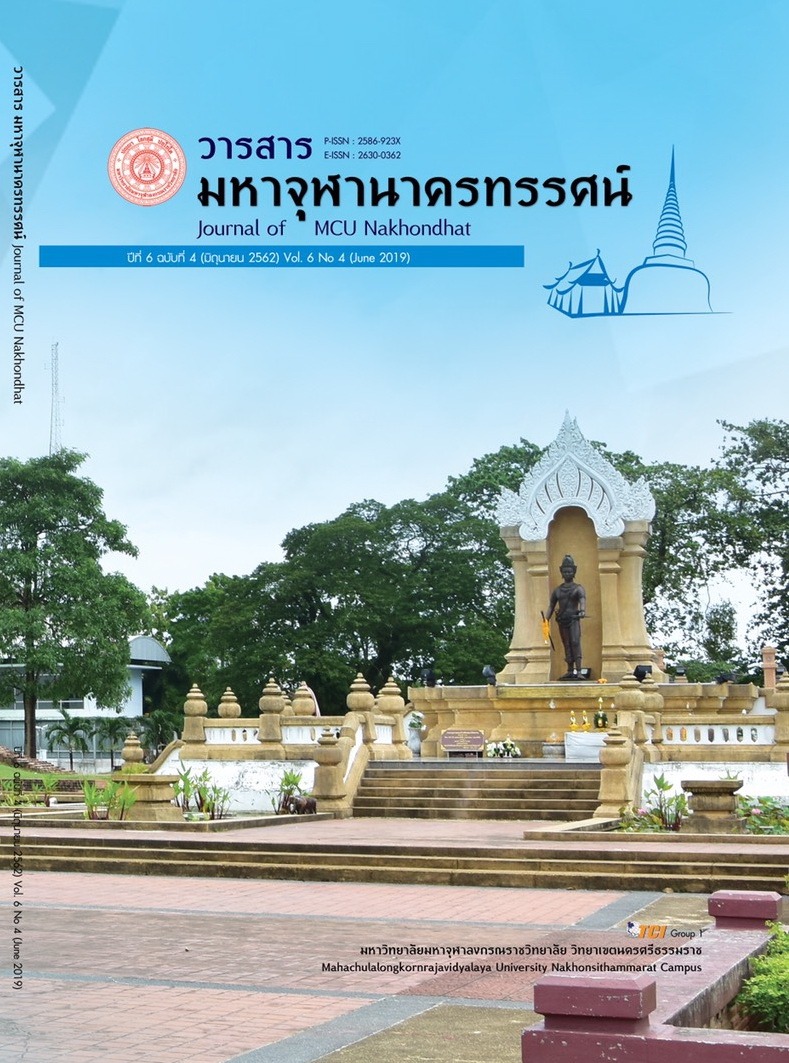DEVELOPMENT OF INNOVATION FOR PROTOTYPE YOUTH ENHANCEMENT IN ACCORDANCE WITH EDUCATIONAL ERFORM POLICY FOR HIGH SCHOOL STUDENTH
Main Article Content
Abstract
The objectives of this research were 1) to study the condition of enhancing the model's youth characteristics in accordance with the educational reform policy 2) to study the innovation to enhance the model's youth characteristics in accordance with the educational reform policy Education for high school students By using a method of research that combines methods such as quantitative research By using a sample of 374 people. Statistics using percentage, mean, standard deviation and qualitative research by interviewing 10 qualified people, discussing 10 expert groups / person
The research found that:
The condition of enhancing the characteristics of the youth model according to the educational reform policy in all 4 aspects found that the overall opinion was at a high level. Sort by average from descending to the most sober Tolerance Love country Have a moral with both physical and mental readiness and Be a good person, a good person, have ethics, have a volunteer spirit for social development. Side is committed Indomitable and knowledgeable, witty and intelligent
To study the innovation of strengthening the model of youth in accordance with the educational reform policy, namely, social studies courses, teaching and learning management), focusing on activities Learner-centered Media / activities), including standing up to respect the national flag, singing the national anthem, using the correct Thai language, both speaking, dressing, using appliances Thai style living, love the country Have a moral With both physical and mental readiness and A good person, a good person Evaluation: Evaluation of students with creativity Science course Teaching and learning) including STEM education, media / activities, including situation studies Analyze the situation Group surveying equipment that teachers prepare Brainstorming, summarizing the results / features received) including knowledge, wit, intelligence and consciousness, perseverance, tolerance, evaluation, evaluation, including new ideas, sufficiency economy courses Integrate education to the sufficiency economy Media / activities include Teacher clarified STEM activities, discussing and reviewing knowledge on sufficiency economy philosophy. Villagers demonstrating practices with materials in the community Students practice to analyze the results obtained from the practice. The results / features received include: commitment, indefinite, evaluation, evaluation) including economic values
Propose innovation to create youth model based on educational reform policy for secondary school students Love country Have a moral with both physical and mental readiness and Be a good person, a good person, have ethics, have a volunteer spirit for social development. Social Studies courses are taught) including activities Learner-centered Media / activities), including standing up to respect the national flag, singing the national anthem, using the correct Thai language, both speaking, dressing, using appliances Thai style living, love the country Have a moral With both physical and mental readiness and A good person, a good person Evaluation: Evaluation of students with creativity With knowledge, wit, intelligence, and consciousness, firmly endured in science courses Teaching and learning) including STEM education, media / activities, including situation studies Analyze the situation Group surveying equipment that teachers prepare Brainstorming, summarizing the results / features received), including knowledge, wit, intelligence and consciousness, perseverance, tolerance, evaluation, evaluation, including new ideas, commitment Not indomitable in the sufficiency economy course Integrate education to the sufficiency economy Media / activities include Teacher clarified STEM activities, discussing and reviewing knowledge on sufficiency economy philosophy. Villagers demonstrating practices with materials in the community Students practice to analyze the results obtained from the practice. The result / feature received is determination, indefinite, evaluation, evaluation) namely economic value, innovation, youth development, both prototypes can be practiced according to the CIACE MODEL.
Article Details
References
ชูชาติ บุญชู. (2540). การยอมรับนวัตกรรมทางการศึกษาของครูประถมศึกษาในจังหวัด ลพบุรี. กรุงเทพมหานคร: จุฬาลงกรณ์มหาวิทยาลัย.
พระธรรมปิฎก (ประยุทธ์ ปยุตฺโต). (2539). การศึกษากับการพัฒนาทรัพยากรมนุษย์. โรงพิมพ์การศาสนา: กรุงเทพมหานคร.
สำนักงานเลขานุการของคณะกรรมการยุทธศาสตร์ชาติ. (2561). ยุทธศาสตร์ชาติ พ.ศ. 2561 – 2580 (ฉบับย่อ). กรุงเทพมหานคร.
สุชาติ วัฒนชัย และคณะ. (2550). ออกแบบและพัฒนานวัตกรรมการเรียนรู้ที่ส่งเสริมการคิด. ใน วิทยานิพนธ์ดุษฎีบัณฑิต คณะศึกษาศาสตร์ สาขาวิชาเทคโนโลยีทางการศึกษา . มหาวิทยาลัยขอนแก่น.
เอื้อมอร ชลวร. (2555). การจัดการความรู้เชิงพุทธบูรณาการ. ใน วิทยานิพนธ์พุทธศาสตรดุษฎีบัณฑิต คณะพุทธศาสตร์ สาขาวิชาพระพุทธศาสนา. มหาวิทยาลัยมหาจุฬาลงกรณราชวิทยาลัย.


